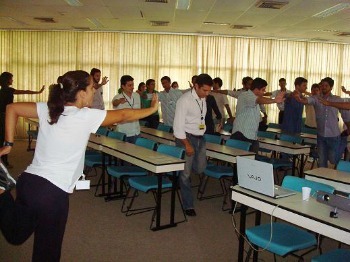Labor Gymnastics is the type of gymnastics whose practice is specifically aimed at employees in their workplace.
In order to prevent injuries and other illnesses caused by occupational activity, exercise (which lasts on average between 5 and 15 minutes) brings many benefits. Examples are reduced fatigue and increased productivity.
Benefits
Many people do not exercise, mainly because of lack of time. Thus, they lead a sedentary life.
This is the case of those who work at the computer, or workers who perform repetitive movements for entire days.
For them, the introduction of physical exercise practices throughout the work activity brings a series of benefits, among which we cite:
- Reduction of fatigue, of the sedentary lifestyle and stress
- Prevention of Repetitive Illnesses such as Reading (Repetitive Strain Injuries) and Dort (Work-Related Musculoskeletal Disorders)
- Improved blood circulation
- Improvement of aspects related to tendons
- posture correction
- Improved relationship between co-workers
- Improved concentration and work pace
- Productivity increase
For companies, all of this also results in a reduction in expenses arising from the costs of sick leave.

Types
There are at least two types of labor gymnastics: preparatory and compensatory.
preparatory gymnastics: lasting between 5 and 10 minutes, it is done in the first hours of the working day or before starting. It consists of warming up and/or stretching.
compensatory gymnastics: is done during the working day. It consists of relaxation and muscle relaxation exercises.
There is also the relaxation, which can guarantee the relief of tensions at the end of the working day.
History
Gymnastics at work arises from the need to prevent reading and pain, diseases that affect the muscles.
Its practice dates back to 1925 in Poland. Then it was the turn of the Netherlands and Russia and, even later, Germany, Belgium, Japan and Sweden. In 1968, the United States turned its attention to this type of physical activity.
In Brazil, the practice dates back to 1901. The first company to provide gymnastics to its employees was Fábrica de Telas Bangu, followed by Banco do Brasil.
As time went by, more importance was given to the subject. Thus, a higher course in this area emerged at the School of Physical Education at the Federal University of Rio Grande do Sul, in 1999.
More and more companies tend to be concerned about the health of their employees. This is because it is certain that people's physical condition reflects on their professional performance.
Read too: Fitness

